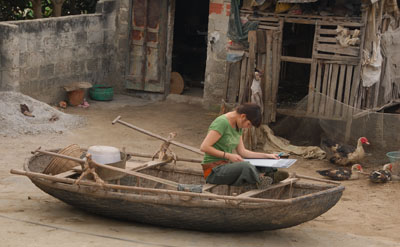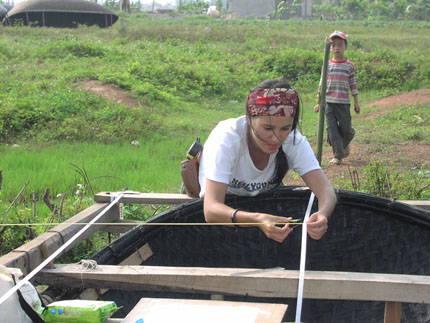
Sketching a basket boat, Quang Ninh province (photo by Randy Sasaki © R. Sasaki).
Ethnographic Boat Recording
Ethnographic study of present day boat building traditions is also a way to go back in time. Maritime ethnography can yield identification of early boat types, bring an insight on early seafaring and make it possible to draw parallels with past conceptions and methods of construction. A boat is not only a means of transportation solely dictated by function or environment, but can be considered as a mirror of the associated culture reflecting various cultural components through its shape, construction and use. This can provide a better understanding of the practical aspects of life along the coast of Cochinchina.
Maritime ethnography is a sub-field of maritime archaeology that aims to record present day maritime material culture. The underlying purpose and methodology, however, is based on the notion that studying living traditions and compiling contemporary data on boat uses and technology increases the sources of information relevant to understanding boats as significant artefacts of the past. This in turn helps to understand past maritime societies and the material retrieved from archaeological excavations. Not only does this kind of study contribute to preserving craft tradition over the long term, it also helps to understand in more depth the reasons for technological innovation and cultural change.
Practically speaking, this involves accurate recording of contemporary vessels through both archival research and field work. The former includes the analysis of historical documents, iconographic data, past accounts, as well as the study of the environment and the historical socio-economic factors that shaped the cultural setting in which the boats were built.
Maritime ethnography furthermore involves systematic recording surviving boat traditions. This entails taking measurements, photographs, and notes of both specific details and main features, in order to draw the boat with its related instruments and appendages. The systematic graphic record is essential to mark technological changes, adaptations and to map diversity. This methodological step is referred to as "boat recording". In addition, discussion with the boatbuilders and owners reveal important information about the tools, materials and design concepts as well as the use, cargo types, and navigation capabilities. This methodological approach provides a deeper understanding of the boat as a product of culture and enables us to grasp the realities that are often hidden in archaeological contexts, iconography or textual descriptions. This step is referred to as "boat builder interviewing."
The systematic graphical record is essential to mark technological changes, adaptations and to map the diversity.
The field work is being conducted in 2012-2013.

Measuring a basket boat, Quang Ninh province (photo by Jun Kimura © J. Kimura).
Previous
